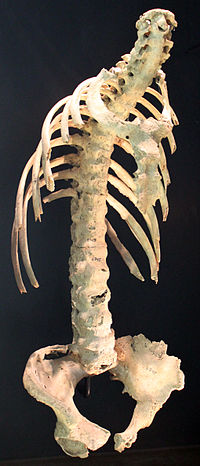
Photo from wikipedia
The objective of the current study was to determine the test-retest reliability of heel-to-toe progression measures in the stance phase of gait using intraclass correlation coefficient (ICC) analysis. It has… Click to show full abstract
The objective of the current study was to determine the test-retest reliability of heel-to-toe progression measures in the stance phase of gait using intraclass correlation coefficient (ICC) analysis. It has been proposed that heel-to-toe progression could be used as a functional measure of ankle muscle contracture/weakness in clinical populations. This was the first study to investigate the test-retest reliability of this measure. Eighteen healthy subjects walked over the GAITRite® mat three times at a comfortable speed on two sessions (≥ 48 hours apart). The reliability of the heel-to-toe progression measures; heel-contact time, mid-stance time and propulsive time were assessed. Also assessed were basic temporal-spatial parameters; velocity, cadence, stride length, step length, stride width, single and double leg support time. Reliability was determined using the ICC(3,1) model and, fixed and proportional biases, and measures of variability were assessed. Basic gait temporal-spatial parameters were not different between sessions (p > 0.05) and had excellent reliability (ICC(3,1) range: 0.871–0.953) indicating that subjects walked similarly between sessions. Measurement of heel-to-toe progression variables were not different between sessions (p > 0.05) and had excellent reliability (ICC(3,1) range: 0.845–0.926). However, these were less precise and more variable than the measurement of standard temporal-spatial gait variables. As the current study was performed on healthy populations, it represents the ‘best case’ scenario. The increased variability and reduced precision of heel-to-toe progression measurements should be considered if being used in clinical populations.
Journal Title: PLoS ONE
Year Published: 2018
Link to full text (if available)
Share on Social Media: Sign Up to like & get
recommendations!